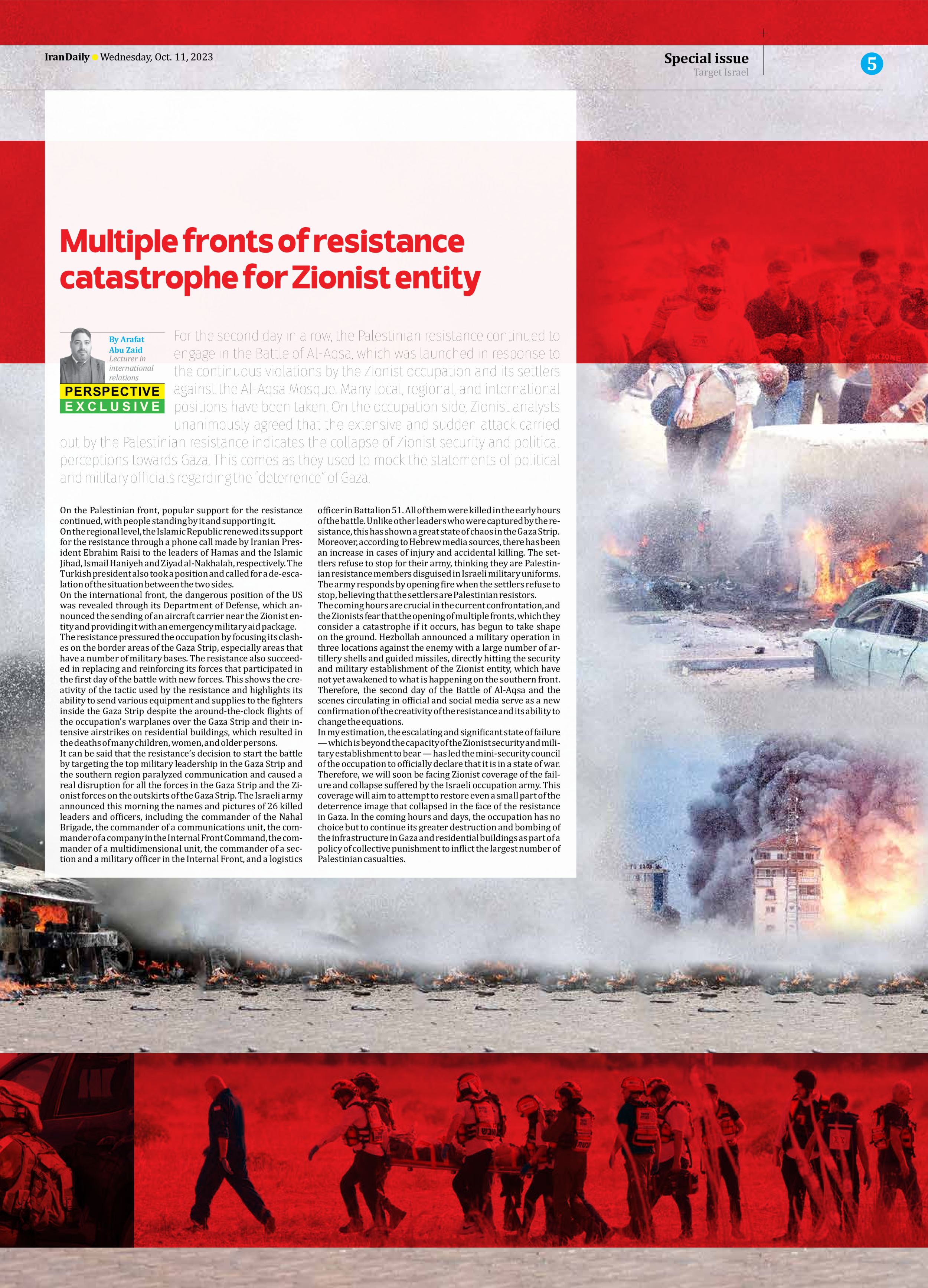
Multiple fronts of resistance catastrophe for Zionist entity
By Arafat Abu Zaid
Lecturer in international relations
For the second day in a row, the Palestinian resistance continued to engage in the Battle of Al-Aqsa, which was launched in response to the continuous violations by the Zionist occupation and its settlers against the Al-Aqsa Mosque. Many local, regional, and international positions have been taken. On the occupation side, Zionist analysts unanimously agreed that the extensive and sudden attack carried out by the Palestinian resistance indicates the collapse of Zionist security and political perceptions towards Gaza. This comes as they used to mock the statements of political and military officials regarding the “deterrence” of Gaza.
On the Palestinian front, popular support for the resistance continued, with people standing by it and supporting it.
On the regional level, the Islamic Republic renewed its support for the resistance through a phone call made by Iranian President Ebrahim Raisi to the leaders of Hamas and the Islamic Jihad, Ismail Haniyeh and Ziyad al-Nakhalah, respectively. The Turkish president also took a position and called for a de-escalation of the situation between the two sides.
On the international front, the dangerous position of the US was revealed through its Department of Defense, which announced the sending of an aircraft carrier near the Zionist entity and providing it with an emergency military aid package.
The resistance pressured the occupation by focusing its clashes on the border areas of the Gaza Strip, especially areas that have a number of military bases. The resistance also succeeded in replacing and reinforcing its forces that participated in the first day of the battle with new forces. This shows the creativity of the tactic used by the resistance and highlights its ability to send various equipment and supplies to the fighters inside the Gaza Strip despite the around-the-clock flights of the occupation’s warplanes over the Gaza Strip and their intensive airstrikes on residential buildings, which resulted in the deaths of many children, women, and older persons.
It can be said that the resistance’s decision to start the battle by targeting the top military leadership in the Gaza Strip and the southern region paralyzed communication and caused a real disruption for all the forces in the Gaza Strip and the Zionist forces on the outskirts of the Gaza Strip. The Israeli army announced this morning the names and pictures of 26 killed leaders and officers, including the commander of the Nahal Brigade, the commander of a communications unit, the commander of a company in the Internal Front Command, the commander of a multidimensional unit, the commander of a section and a military officer in the Internal Front, and a logistics officer in Battalion 51. All of them were killed in the early hours of the battle. Unlike other leaders who were captured by the resistance, this has shown a great state of chaos in the Gaza Strip.
Moreover, according to Hebrew media sources, there has been an increase in cases of injury and accidental killing. The settlers refuse to stop for their army, thinking they are Palestinian resistance members disguised in Israeli military uniforms. The army responds by opening fire when the settlers refuse to stop, believing that the settlers are Palestinian resistors.
The coming hours are crucial in the current confrontation, and the Zionists fear that the opening of multiple fronts, which they consider a catastrophe if it occurs, has begun to take shape on the ground. Hezbollah announced a military operation in three locations against the enemy with a large number of artillery shells and guided missiles, directly hitting the security and military establishment of the Zionist entity, which have not yet awakened to what is happening on the southern front. Therefore, the second day of the Battle of Al-Aqsa and the scenes circulating in official and social media serve as a new confirmation of the creativity of the resistance and its ability to change the equations.
In my estimation, the escalating and significant state of failure — which is beyond the capacity of the Zionist security and military establishment to bear — has led the mini-security council of the occupation to officially declare that it is in a state of war. Therefore, we will soon be facing Zionist coverage of the failure and collapse suffered by the Israeli occupation army. This coverage will aim to attempt to restore even a small part of the deterrence image that collapsed in the face of the resistance in Gaza. In the coming hours and days, the occupation has no choice but to continue its greater destruction and bombing of the infrastructure in Gaza and residential buildings as part of a policy of collective punishment to inflict the largest number of Palestinian casualties.







